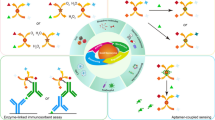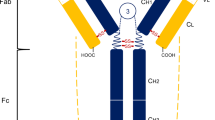Abstract
A kind of biocatalyst, laccase, has been employed as a biocompatible coreactant accelerator to efficiently catalyze coreactant (dissolved O2) for generating high local concentration of superoxide radical (O2•−), acquiring high-intense electrochemiluminescence (ECL) emission of ABEI (N-(aminobutyl)-N-(ethylisoluminol))/dissolved O2 system. Furthermore, a modified strand displacement reaction with excellent amplification efficiency was constructed by replacing traditional single strand DNA to the hairpin DNA as template for triggering the immobilization of more signal probes. As a result, the biosensor for microRNA-21 determination has preeminent selectivity and favorable sensitivity with detection limit down to 80.8 aM. Significantly, the devised strategy has blazed a new path for seeking more coreaction accelerators with splendid biocompatibility thus promoting the application of ternary ECL systems in biological analysis and clinical diagnosis.
Graphical abstract







Similar content being viewed by others
References
Maar RR, Zhang RZ, Stephens DG, Ding ZF, Gilroy JB (2019) Near-infrared photoluminescence and electrochemiluminescence from a remarkably simple boron difluoride formazanate dye. Angew Chem Int Ed 58:1052–1056
Zhang P, Jiang J, Yuan R, Zhuo Y, Chai Y (2018) Highly ordered and field-free 3D DNA nanostructure: the next generation of DNA nanomachine for rapid single-step sensing. J Am Chem Soc 140:9361–9364
Zanut A, Palomba F, Scota M, Rebeccani S, Marcaccio M, Genovese D, Rampazzo E, Valenti G, Paolucci F, Prodi L (2020) Chameleon metals: autonomous nano-texturing and composition inversion on liquid metals surfaces. Angew Chem Int Ed 59:1
Ying Z, Chen S, Luo X, Chai Y, Yuan R (2018) Ternary electrochemiluminescence nanostructure of Au nanoclusters as a highly efficient signal label for ultrasensitive detection of cancer biomarkers. Anal Chem 90:10024
Tang TT, Yang F, Wang L, Zhao CX, Nie F, Yang GP (2020) A sandwich electrochemiluminescent assay for determination of concanavalin A with triple signal amplification based on MoS2NF@MWCNTs modified electrode and Zn-MOF encapsulated luminol. Microchim Acta 187:523
Gu W, Wang H, Jiao L, Wu Y, Chen Y, Hu L, Gong J, Du D, Zhu C (2020) Single-atom iron boosts electrochemiluminescence. Angew Chem Int Ed 59:3534–3538
Xing HH, Peng C, Xue Y, Fan YC, Li J, Wang EK (2020) In situ formed catalytic interface for boosting chemiluminescence. Anal Chem 92:10108–10113
Liu JL, Tang ZL, Zhuo Y, Chai YQ, Yuan R (2017) Ternary electrochemiluminescence system based on rubrene microrods as luminophore and Pt nanomaterials as coreaction accelerator for ultrasensitive detection of microRNA from cancer cells. Anal Chem 89(17):9108–9115
Zhang R, Chen AY, Yu YQ, Chai YQ, Zhuo Y, Yuan R (2018) Electrochemiluminescent carbon dot-based determination of microRNA-21 by using a hemin/G-wire supramolecular nanostructure as co-reaction accelerator. Microchim Acta 185:432
Wu FF, Zhou Y, Zhang H, Yuan R, Chai YQ (2018) Electrochemiluminescence peptide-based biosensor with hetero-nanostructures as coreaction accelerator for the ultrasensitive determination of tryptase. Anal Chem 90(3):2263–2270
Pan J, Wang X, Huang Q, Shen C, Koh Z, Wang Q, Engel A, Bahnemann DW (2014) Large-scale synthesis of urchin-like mesoporous TiO2 hollow spheres by targeted etching and their photoelectrochemical properties. Adv Funct Mater 24:95–104
Roberts JG, Voinov AM, Schmidt AC, Smirnova TI, Sombers LA (2016) The hydroxyl radical is a critical intermediate in the voltammetric detection of hydrogen peroxide. J Am Chem Soc 138:2516–2519
Fang DD, Zeng BS, Zhang SP, Dai H, Lin YY (2020) A self-enhanced electrochemiluminescent ratiometric zearalenone immunoassay based on the use of helical carbon nanotubes. Microchim Acta 187:303
Bruch R, Baaske J, Chatelle C, Meirich M, Madlener S, Weber W, Dincer C, Urban G (2019) CRISPR/Cas13a-powered electrochemical microfluidic biosensor for nucleic acid amplification-free miRNA diagnostics. Adv Mater 31:1905311
Liu L, Yao Y, Ma KJ, Shangguan CJ, Jiao SL, Zhu SY, Xu XX (2021) Ultrasensitive photoelectrochemical detection of cancer-related miRNA-141 by carrier recombination inhibition in hierarchical Ti3C2@ReS2. Sensors Actuators B Chem 331:129470
Xian L, Ge H, Xu F, Xu N, Fan J, Shao K, Peng X (2019) Intracellular microRNA imaging using telomerase-catalyzed FRET ratioflares with signal amplification. Chem Sci 10:7111–7118
Yang K, Li JN, de la Chapelle ML, Huang GR, Wang YX, Zhang JB, Xu DG, Yao JQ, Yang X, Fu WL (2021) A terahertz metamaterial biosensor for sensitive detection of microRNAs based on gold-nanoparticles and strand displacement amplification. Biosens Bioelectron 175:112874
Ye J, Liu G, Yan M, Zhu Q, Zhu L, Huang J, Yang X (2019) Highly luminescent and self-enhanced electrochemiluminescence of tris(bipyridine) ruthenium(II) nanohybrid and its sensing application for label-free detection of microRNA. Anal Chem 91:13237–13243
Xue C, Zhang S, Ouyang C, Chang D, Salena B, Li Y, Wu Z (2018) Target-induced catalytic assembly of Y-shaped DNA and its application for in situ imaging of microRNAs. Angew Chem Int Ed 57:9739–9743
Yan N, Wang XJ, Lin L, Song TJ, Sun PJ, Tian HY, Liang HJ, Chen XS (2018) Gold nanorods electrostatically binding nucleic acid probe for in vivo microRNA amplified detection and photoacoustic imaging-guided photothermal therapy. Adv Funct Mater 28:1800490
Funding
This work was financially supported by the NNSF of China (21974108, and 21775124), and Postdoctoral Science Foundation of China (2019 M663418).
Author information
Authors and Affiliations
Corresponding author
Ethics declarations
Conflict of interest
The authors declare that they have no competing interests.
Additional information
Publisher’s note
Springer Nature remains neutral with regard to jurisdictional claims in published maps and institutional affiliations.
Supplementary information
ESM 1
(DOCX 743 kb)
Rights and permissions
About this article
Cite this article
Zhou, Y., Liao, H., Chai, Y. et al. Electrochemiluminescence from a biocatalysis accelerated N-(aminobutyl)-N-(ethylisoluminol)/dissolved O2 system for microRNA detection. Microchim Acta 188, 205 (2021). https://doi.org/10.1007/s00604-021-04854-6
Received:
Accepted:
Published:
DOI: https://doi.org/10.1007/s00604-021-04854-6




